Analys
Upside is the way to go both front end and back end. Go buy Brent Dec-2020 at $58/bl

 After hitting a fresh 2015 high of $64.65/bl last week on the back of spiralling geopolitical risk it is not too surprising that the front month Brent crude is taking a small breather. Yesterday it closed at $63.16/bl while it is pulling back another 0.5% to $62.8/bl this morning. The longer dated contracts like the Brent December 2020 have however continued to gain ground with a close yesterday of $58.13/bl. US inflation is currently running at about 2%. Assume simplistically that this is the inflation rate also the next three years to December 2020. The future Brent Dec-2020 contract is a nominal price. This means that in real terms (adjusting for 2% yearly inflation) the current Brent Dec 2020 is currently priced at $54.7/bl in real terms while it is $58.13/bl in nominal terms.
After hitting a fresh 2015 high of $64.65/bl last week on the back of spiralling geopolitical risk it is not too surprising that the front month Brent crude is taking a small breather. Yesterday it closed at $63.16/bl while it is pulling back another 0.5% to $62.8/bl this morning. The longer dated contracts like the Brent December 2020 have however continued to gain ground with a close yesterday of $58.13/bl. US inflation is currently running at about 2%. Assume simplistically that this is the inflation rate also the next three years to December 2020. The future Brent Dec-2020 contract is a nominal price. This means that in real terms (adjusting for 2% yearly inflation) the current Brent Dec 2020 is currently priced at $54.7/bl in real terms while it is $58.13/bl in nominal terms.
In other words consumers can still purchase forward the Dec-2020 at less than $55/bl in real terms. The frame work reflection around this is that US shale oil players are not making satisfying returns with a crude oil price of $50/bl. So the general assumption is that they need a higher price than that. What we also have seen since the start of the year and accelerating so over the latest months is that the Brent to WTI price has widened out as increasing production has hit pipeline export constraints in the US from Cushing Oklahoma to the US Gulf. It can be mended but it takes time.
A strong US crude oil production growth to 2020 is both needed and probable. But it requires more than $50/bl for US shale oil players. It is also likely to imply a wide Brent to WTI price spread. At the moment the WTI Dec 2020 contract is trading at only $52/bl. It should at least reflate up to $55/bl on the assumption that the global oil market will need a lot of US shale oil production growth to 2020. Currently the Brent to WTI Dec 2020 crude spread is a full $6/bl. This seems fair in a scenario of strongly increasing US shale oil production.
This kind of base assumption thus places Brent Dec-2020 outlook easily at $60/bl as some kind of floor-price assumption in a scenario where the world will need a solid growth in US shale oil production. Of course if we have a global recession in the run-up to 2020 there is no price floor to talk about and the oil price could obviously deliver below the $60/bl in that case.
However if we assume a Brent 2020 “floor price” of $60/bl then there is no geopolitical risk premium included in that price and there is no cyclical investment upside price spike risk included in that (investment cuts since 2014 leading to structural deficit in 2020. So consumers contemplating purchasing crude oil or oil products on the 2020 horizon should act as Brent Dec 2020 at a nominal price of $58/bl (and real price of $54.7/bl) is still a very, very good offer.
Our expectation is that the Brent Dec 2020 contract will reflate yet higher and into the $60is/bl.
We also expect the Brent to WTI price spread to widen out yet further. In its latest forecast the US EIA predicts US crude oil production to increase 15 kbl/day each week from December to May when it will hit 10 mbl/day. Thus US export pipelines and pipeline infrastructure is going to be under more and more pressure every week all the way to May at least. The WTI crude oil benchmark is priced in-land in Cushing Oklahoma and that price has to scream: “NO MORE” to US shale oil players even if the world needs more of it. The WTI price has to say stop becuse of lack of capacity to get it to market. Inventories there are already brimming full and rising as pipes to the US Gulf are already running full.
So again we have a two wheel crude oil world. Declining crude and product inventories in the world in total and especially the World ex-US-Mid-Continent while at the same time rising inventories in the US Mid-Continent with increasing bottlenecks and transportation issues. Thus a tightening Brent crude market on the one side and a weakening WTI crude market on the other side.
One possible hitch in this argument is however that Permian and Eagle Ford producers may not have to ship their crude oil through Cushing Oklahoma as they are further to the west. Is there enough pipline capacity from Permian and Eagle Ford to get their oil directly to the US Gulf circumventing Cushing? If that is the case then Permian and Eagle Ford producers are actually getting US Gulf crude oil prices for their crude oil which is close to Brent prices. That would mean that those two fields are currently experiencing STRONG price stimulus from US Gulf crude prices and not the WEAK Cushing Oklahoma WTI prices.
Our view on geopolitics is that we are now likely going to experience a long period with a continuous stream of uncomfortable and disturbing news coming out of Saudi Arabia specifically and the Middle East in General. Thus what Mohammed bin Salman set in motion a little more than a week ago is probably only the start of it. In the quite after the Saudi event a week ago the Brent price has eased back. Our expectation is that there is going to be more disturbing geopolitical news items in not too long. Inventories are still declining. OPEC and Russia are likely going to maintain cuts to the end of 2018 but no decision at upcoming OPEC meeting in Vienna on 30th November. Investors continue to flock into front end Brent backwardation positive roll yield and the upside is the way to go for Brent. Both for the front end contract as well as for the longer dated Brent Dec-2020.
Adding in geopolitical risks to the whole mix of declining inventories (ex-US-Mid-Continent), increasing Brent to WTI price spread, increasing Brent backwardation, strong global demand growth, positive Brent roll yield in a zero interest rate world sucking in more speculative long positions, well then seeing the Brent front month sniffing close to the $70/bl seems like the likely price action. Not long ago we said that it was likely to see Brent touching up to $65/bl before Christmas, but then we had no strong geopolitical driver in our assumption besides the Kurdistan issue. Now the central bank of oil, Saudi Arabia, is added to the mix of geopolitical concerns.
So upside is the way to go for the time being. Both for front end Brent and the Dec-2020.
Kind regards
Bjarne Schieldrop
Chief analyst, Commodities
SEB Markets
Merchant Banking
Analys
More weakness and lower price levels ahead, but the world won’t drown in oil in 2026

Some rebound but not much. Brent crude rebounded 1.5% yesterday to $65.47/b. This morning it is inching 0.2% up to $65.6/b. The lowest close last week was on Thursday at $64.11/b.

The curve structure is almost as week as it was before the weekend. The rebound we now have gotten post the message from OPEC+ over the weekend is to a large degree a rebound along the curve rather than much strengthening at the front-end of the curve. That part of the curve structure is almost as weak as it was last Thursday.
We are still on a weakening path. The message from OPEC+ over the weekend was we are still on a weakening path with rising supply from the group. It is just not as rapidly weakening as was feared ahead of the weekend when a quota hike of 500 kb/d/mth for November was discussed.
The Brent curve is on its way to full contango with Brent dipping into the $50ies/b. Thus the ongoing weakening we have had in the crude curve since the start of the year, and especially since early June, will continue until the Brent crude oil forward curve is in full contango along with visibly rising US and OECD oil inventories. The front-month Brent contract will then flip down towards the $60/b-line and below into the $50ies/b.
At what point will OPEC+ turn to cuts? The big question then becomes: When will OPEC+ turn around to make some cuts? At what (price) point will they choose to stabilize the market? Because for sure they will. Higher oil inventories, some more shedding of drilling rigs in US shale and Brent into the 50ies somewhere is probably where the group will step in.
There is nothing we have seen from the group so far which indicates that they will close their eyes, let the world drown in oil and the oil price crash to $40/b or below.
The message from OPEC+ is also about balance and stability. The world won’t drown in oil in 2026. The message from the group as far as we manage to interpret it is twofold: 1) Taking back market share which requires a lower price for non-OPEC+ to back off a bit, and 2) Oil market stability and balance. It is not just about 1. Thus fretting about how we are all going to drown in oil in 2026 is totally off the mark by just focusing on point 1.
When to buy cal 2026? Before Christmas when Brent hits $55/b and before OPEC+ holds its last meeting of the year which is likely to be in early December.
Brent crude oil prices have rebounded a bit along the forward curve. Not much strengthening in the structure of the curve. The front-end backwardation is not much stronger today than on its weakest level so far this year which was on Thursday last week.
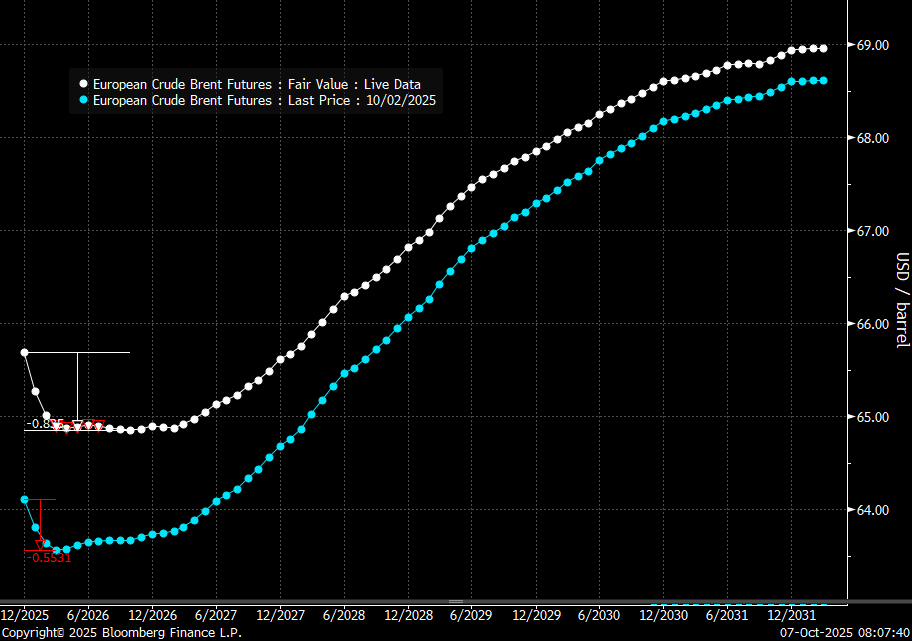
The front-end backwardation fell to its weakest level so far this year on Thursday last week. A slight pickup yesterday and today, but still very close to the weakest year to date. More oil from OPEC+ in the coming months and softer demand and rising inventories. We are heading for yet softer levels.
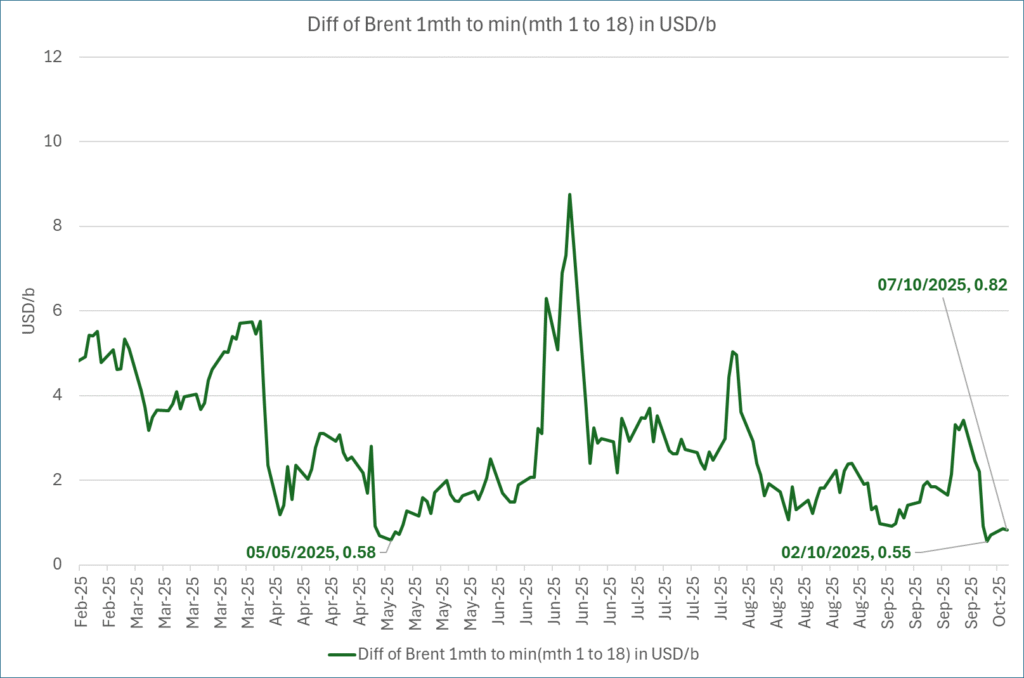
Analys
A sharp weakening at the core of the oil market: The Dubai curve

Down to the lowest since early May. Brent crude has fallen sharply the latest four days. It closed at USD 64.11/b yesterday which is the lowest since early May. It is staging a 1.3% rebound this morning along with gains in both equities and industrial metals with an added touch of support from a softer USD on top.

What stands out the most to us this week is the collapse in the Dubai one to three months time-spread.
Dubai is medium sour crude. OPEC+ is in general medium sour crude production. Asian refineries are predominantly designed to process medium sour crude. So Dubai is the real measure of the balance between OPEC+ holding back or not versus Asian oil demand for consumption and stock building.
A sharp weakening of the front-end of the Dubai curve. The front-end of the Dubai crude curve has been holding out very solidly throughout this summer while the front-end of the Brent and WTI curves have been steadily softening. But the strength in the Dubai curve in our view was carrying the crude oil market in general. A source of strength in the crude oil market. The core of the strength.
The now finally sharp decline of the front-end of the Dubai crude curve is thus a strong shift. Weakness in the Dubai crude marker is weakness in the core of the oil market. The core which has helped to hold the oil market elevated.
Facts supports the weakening. Add in facts of Iraq lifting production from Kurdistan through Turkey. Saudi Arabia lifting production to 10 mb/d in September (normal production level) and lifting exports as well as domestic demand for oil for power for air con is fading along with summer heat. Add also in counter seasonal rise in US crude and product stocks last week. US oil stocks usually decline by 1.3 mb/week this time of year. Last week they instead rose 6.4 mb/week (+7.2 mb if including SPR). Total US commercial oil stocks are now only 2.1 mb below the 2015-19 seasonal average. US oil stocks normally decline from now to Christmas. If they instead continue to rise, then it will be strongly counter seasonal rise and will create a very strong bearish pressure on oil prices.
Will OPEC+ lift its voluntary quotas by zero, 137 kb/d, 500 kb/d or 1.5 mb/d? On Sunday of course OPEC+ will decide on how much to unwind of the remaining 1.5 mb/d of voluntary quotas for November. Will it be 137 kb/d yet again as for October? Will it be 500 kb/d as was talked about earlier this week? Or will it be a full unwind in one go of 1.5 mb/d? We think most likely now it will be at least 500 kb/d and possibly a full unwind. We discussed this in a not earlier this week: ”500 kb/d of voluntary quotas in October. But a full unwind of 1.5 mb/d”
The strength in the front-end of the Dubai curve held out through summer while Brent and WTI curve structures weakened steadily. That core strength helped to keep flat crude oil prices elevated close to the 70-line. Now also the Dubai curve has given in.
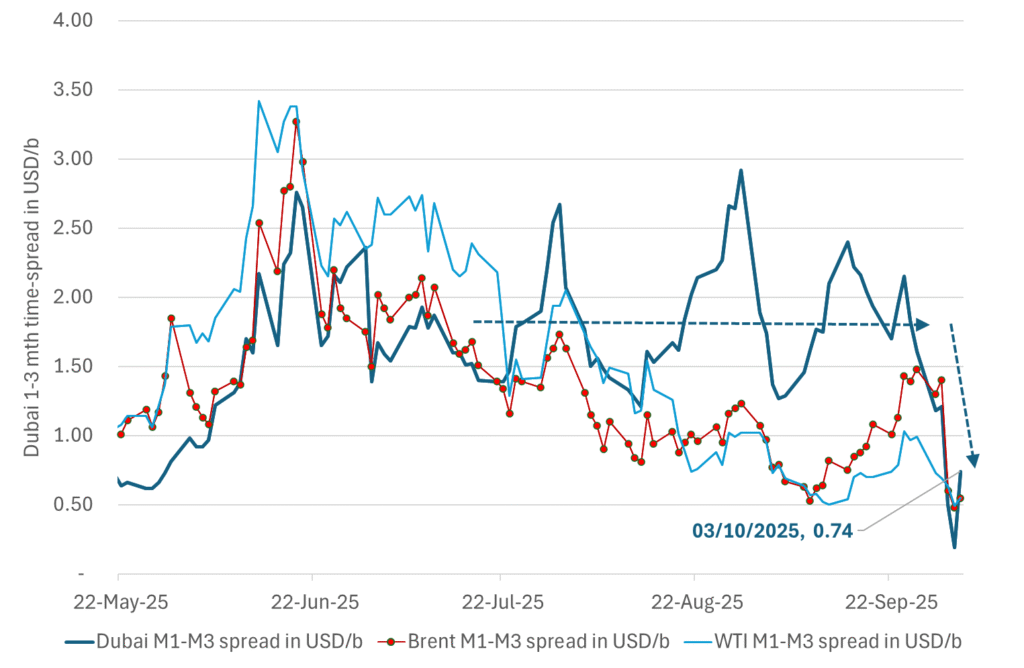
Brent crude oil forward curves
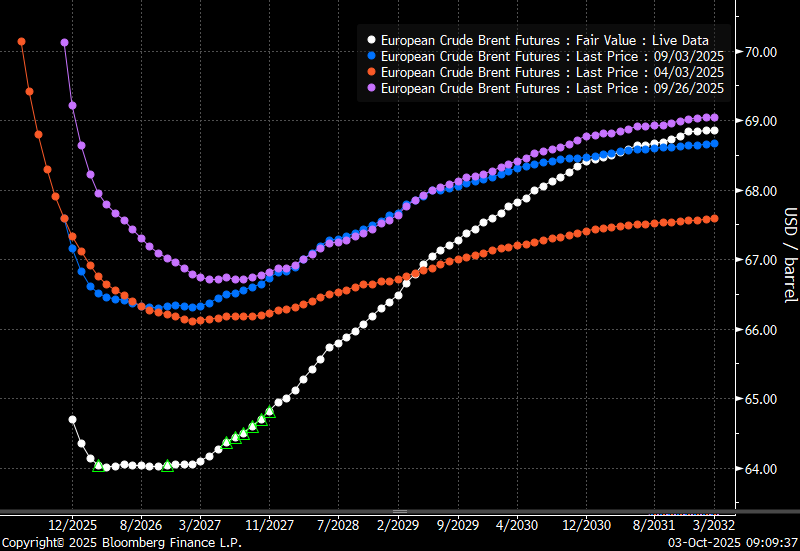
Total US commercial stocks now close to normal. Counter seasonal rise last week. Rest of year?
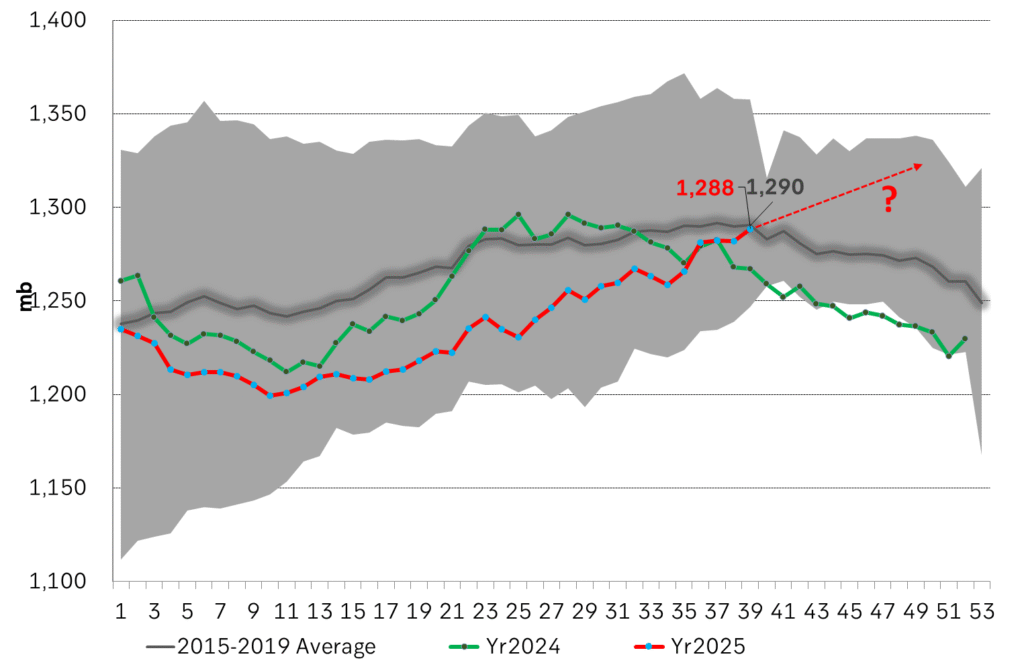
Total US crude and product stocks on a steady trend higher.
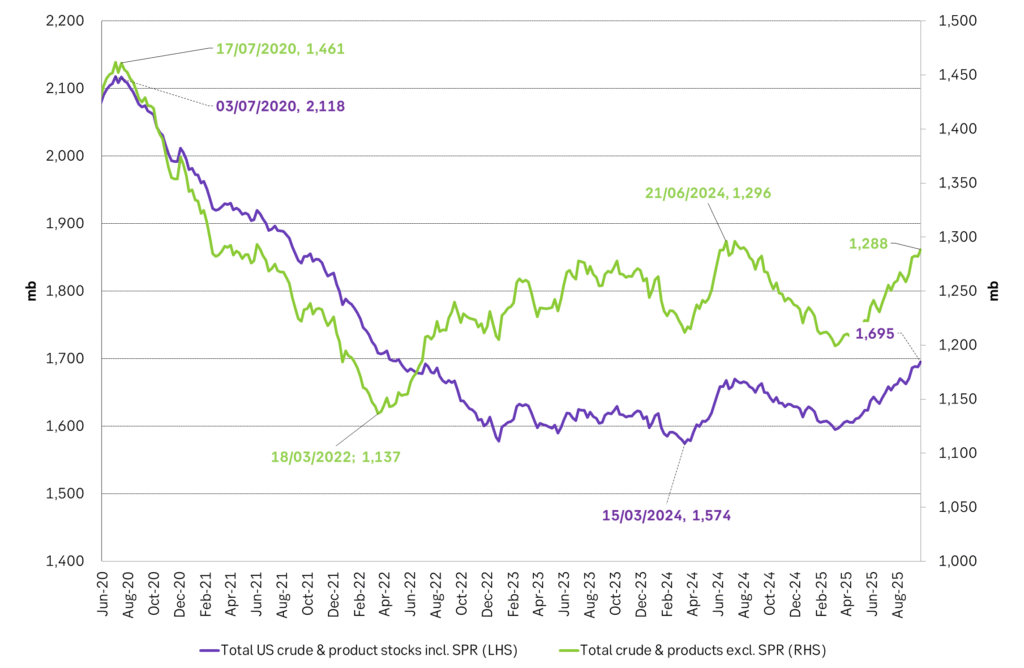
Analys
OPEC+ will likely unwind 500 kb/d of voluntary quotas in October. But a full unwind of 1.5 mb/d in one go could be in the cards

Down to mid-60ies as Iraq lifts production while Saudi may be tired of voluntary cut frugality. The Brent December contract dropped 1.6% yesterday to USD 66.03/b. This morning it is down another 0.3% to USD 65.8/b. The drop in the price came on the back of the combined news that Iraq has resumed 190 kb/d of production in Kurdistan with exports through Turkey while OPEC+ delegates send signals that the group will unwind the remaining 1.65 mb/d (less the 137 kb/d in October) of voluntary cuts at a pace of 500 kb/d per month pace.

Signals of accelerated unwind and Iraqi increase may be connected. Russia, Kazakhstan and Iraq were main offenders versus the voluntary quotas they had agreed to follow. Russia had a production ’debt’ (cumulative overproduction versus quota) of close to 90 mb in March this year while Kazakhstan had a ’debt’ of about 60 mb and the same for Iraq. This apparently made Saudi Arabia angry this spring. Why should Saudi Arabia hold back if the other voluntary cutters were just freeriding? Thus the sudden rapid unwinding of voluntary cuts. That is at least one angle of explanations for the accelerated unwinding.
If the offenders with production debts then refrained from lifting production as the voluntary cuts were rapidly unwinded, then they could ’pay back’ their ’debts’ as they would under-produce versus the new and steadily higher quotas.
Forget about Kazakhstan. Its production was just too far above the quotas with no hope that the country would hold back production due to cross-ownership of oil assets by international oil companies. But Russia and Iraq should be able to do it.
Iraqi cumulative overproduction versus quotas could reach 85-90 mb in October. Iraq has however steadily continued to overproduce by 3-5 mb per month. In July its new and gradually higher quota came close to equal with a cumulative overproduction of only 0.6 mb that month. In August again however its production had an overshoot of 100 kb/d or 3.1 mb for the month. Its cumulative production debt had then risen to close to 80 mb. We don’t know for September yet. But looking at October we now know that its production will likely average close to 4.5 mb/d due to the revival of 190 kb/d of production in Kurdistan. Its quota however will only be 4.24 mb/d. Its overproduction in October will thus likely be around 250 kb/d above its quota with its production debt rising another 7-8 mb to a total of close to 90 mb.
Again, why should Saudi Arabia be frugal while Iraq is freeriding. Better to get rid of the voluntary quotas as quickly as possible and then start all over with clean sheets.
Unwinding the remaining 1.513 mb/d in one go in October? If OPEC+ unwinds the remaining 1.513 mb/d of voluntary cuts in one big go in October, then Iraq’s quota will be around 4.4 mb/d for October versus its likely production of close to 4.5 mb/d for the coming month..
OPEC+ should thus unwind the remaining 1.513 mb/d (1.65 – 0.137 mb/d) in one go for October in order for the quota of Iraq to be able to keep track with Iraq’s actual production increase.
October 5 will show how it plays out. But a quota unwind of at least 500 kb/d for Oct seems likely. An overall increase of at least 500 kb/d in the voluntary quota for October looks likely. But it could be the whole 1.513 mb/d in one go. If the increase in the quota is ’only’ 500 kb/d then Iraqi cumulative production will still rise by 5.7 mb to a total of 85 mb in October.
Iraqi production debt versus quotas will likely rise by 5.7 mb in October if OPEC+ only lifts the overall quota by 500 kb/d in October. Here assuming historical production debt did not rise in September. That Iraq lifts its production by 190 kb/d in October to 4.47 mb/d (August level + 190 kb/d) and that OPEC+ unwinds 500 kb/d of the remining quotas in October when they decide on this on 5 October.
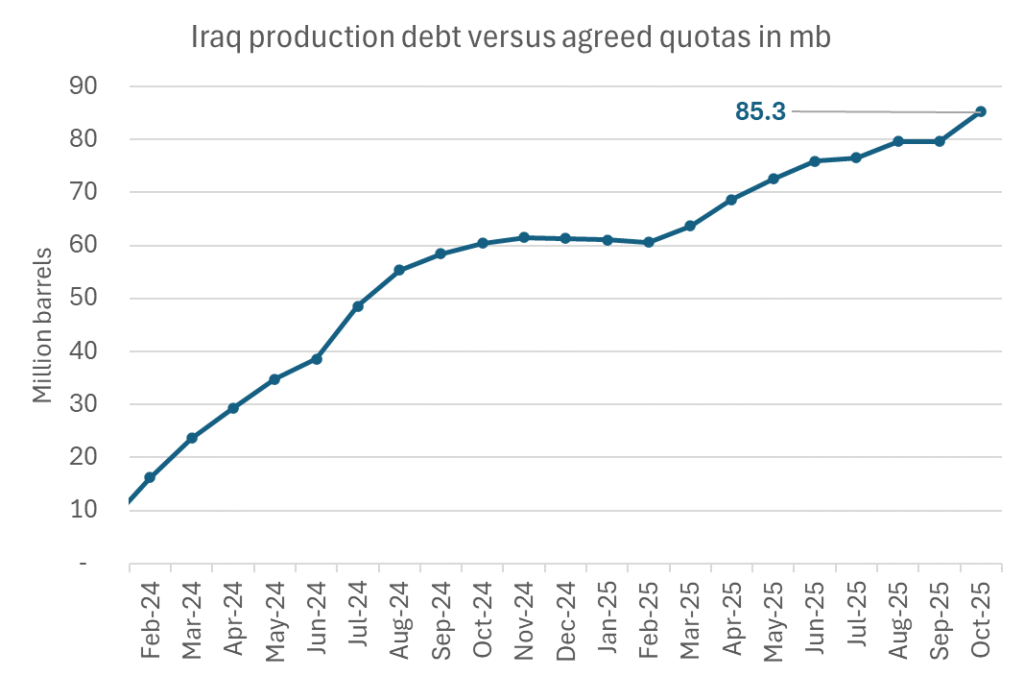
-

 Nyheter4 veckor sedan
Nyheter4 veckor sedanMahvie Minerals i en guldtrend
-

 Analys4 veckor sedan
Analys4 veckor sedanVolatile but going nowhere. Brent crude circles USD 66 as market weighs surplus vs risk
-
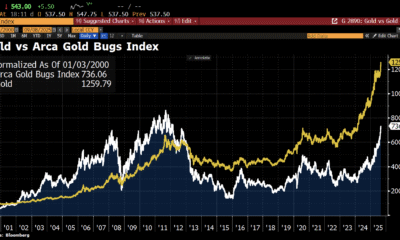
 Nyheter4 veckor sedan
Nyheter4 veckor sedanAktier i guldbolag laggar priset på guld
-

 Nyheter4 veckor sedan
Nyheter4 veckor sedanKinas elproduktion slog nytt rekord i augusti, vilket även kolkraft gjorde
-
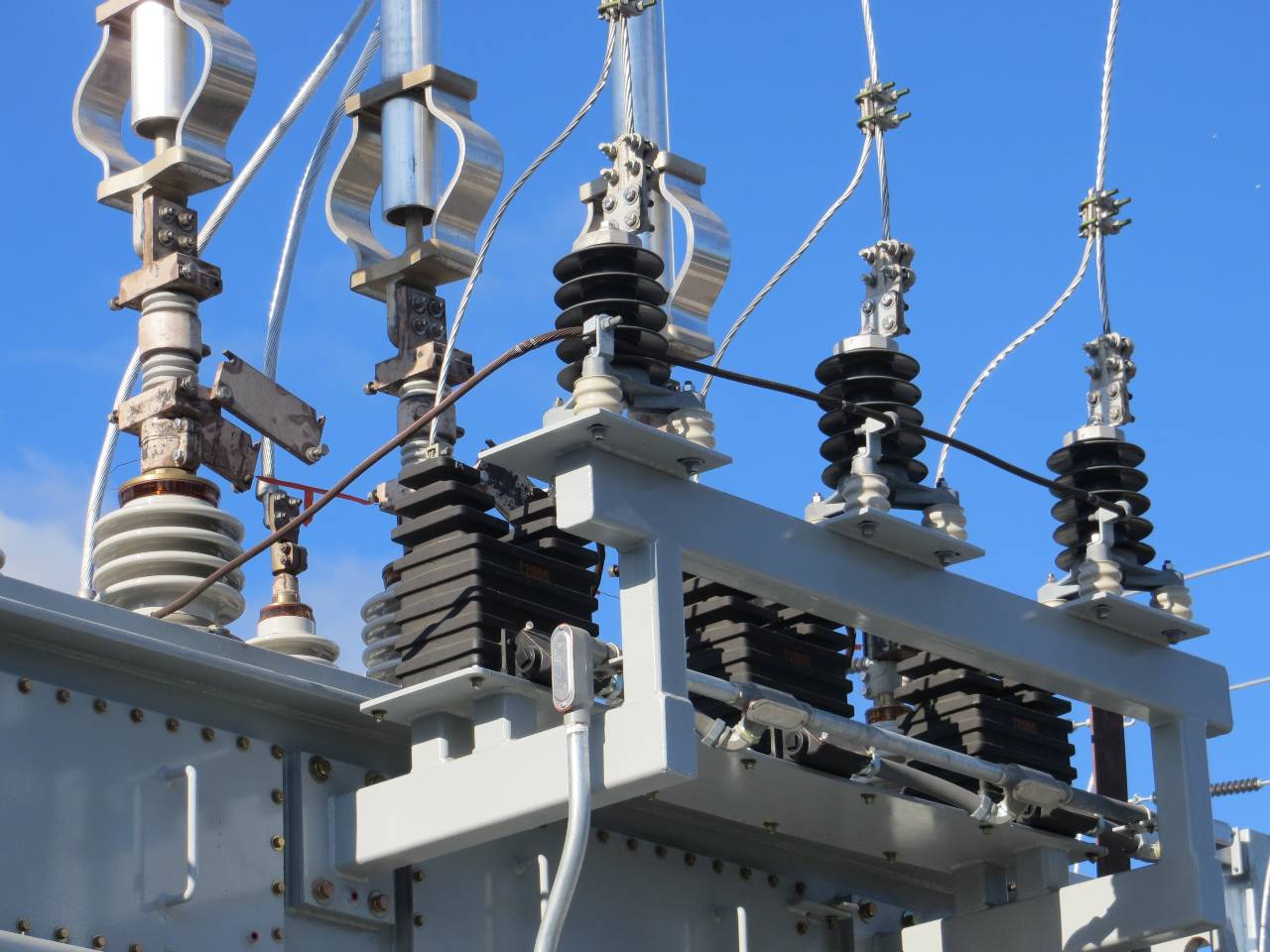
 Nyheter3 veckor sedan
Nyheter3 veckor sedanTyskland har så höga elpriser att företag inte har råd att använda elektricitet
-
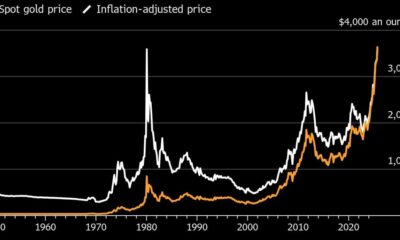
 Nyheter4 veckor sedan
Nyheter4 veckor sedanGuld når sin högsta nivå någonsin, nu även justerat för inflation
-
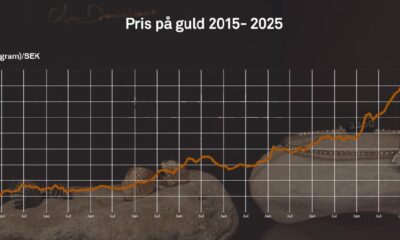
 Nyheter4 veckor sedan
Nyheter4 veckor sedanDet stigande guldpriset en utmaning för smyckesköpare
-

 Analys3 veckor sedan
Analys3 veckor sedanBrent crude ticks higher on tension, but market structure stays soft








